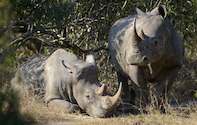
- Black rhinoceros - arid ecotype Diceros bicornis bicornis
- De Winton's golden mole Cryptochloris wintoni
- Juliana's golden mole Neamblysomus julianae (Pretoria subpopn.)
- Ongoye red squirrel Paraxerus palliatus ornatus
- Rendall's serotine bat Neoromicia rendalli
- Riverine rabbit Bunolagus monticularis
- Rough-haired golden mole Chrysospalax villosus
- Short-eared trident bat Cloeotis percivali
- Van Zyl's golden mole Cryptochloris zyli Visagie's golden mole Chrysochloris visagiei
Juliana's Golden Mole
Juliana's golden mole, the third most critically endangered mammal species in South Africa, is found on the north-eastern slope of the 20km long Bronberg Ridge in Eastern Pretoria. One of only three populations of this species in the entire world, Juliana's golden mole is severely threatened by nearby up-market real estate development, roads, and an open-cast quartzite quarry on Bronberg Ridge.Some genetic work done on the population of Juliana's golden mole found in the Kruger National Park has indicated that it may be a separate species. If this is the case, the golden moles on Bronberg Ridge will be in even more grave danger of extinction. Growing on the ridge is also an endemic plant species, Ceropegia decidua subsp Pretoriensis, which is also critically endangered.
De Winton's Golden Mole
Often referred to as 'lake-shore hedgehogs', the golden mole is endemic to South Africa and they're facing an extremely high risk of extinction in the wild on the IUCN's Red List of threatened species. They reside in the coastal dunes and adjacent areas in Strandveld in Namaqualand coastal plains in the Northern Cape. These insectivore are relatively small, having the size of 8 cm, however larger moles grow up to 20 cm in size.Due to diamond mining in Port Nolloth, the sandy dunes where these specimen reside have been affected. Biologists state that it is difficult to gather data regarding these moles as they are commonly confined to remote areas. No conservation actions has been planned yet to save the De Winton's Golden Mole.
The Black Rhinoceros
Numerous conservation efforts are to thank for the estimate of 4 838 critically endangered black that are currently remaining in the wild.The species number has declined by an estimate of 97.6% since 1960. European hunters are accountable for the early decline of black rhino populations. By 1970, there were a total number of 65 000 black rhino left.
The two-horned specimen is suffering at the hands of rhino poachers who use trade their horns for Chinese medicine. Poachers remain the biggest threats to the black rhino species but due to the strict protection their populations are recovering.

 In a world where wildlife has become a precious commodity, Kruger National Park Wildlife Conservation has taken on the responsibility of c...
In a world where wildlife has become a precious commodity, Kruger National Park Wildlife Conservation has taken on the responsibility of c...